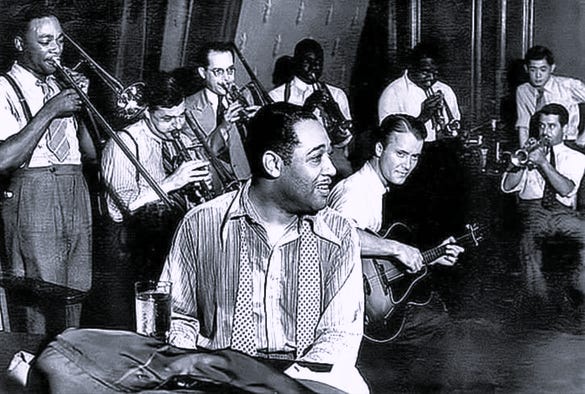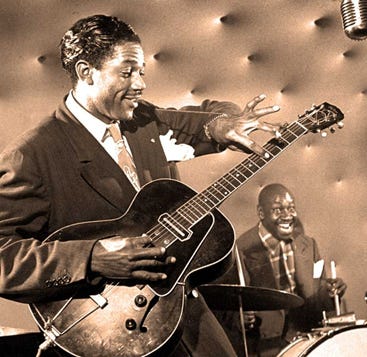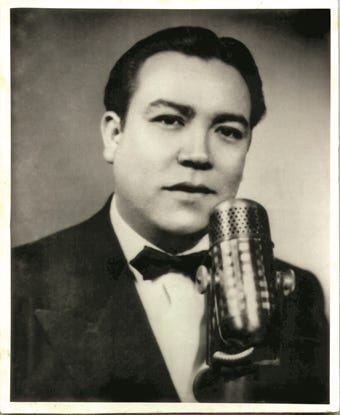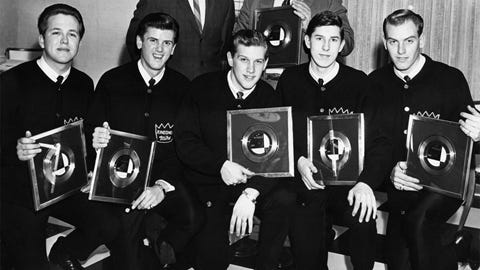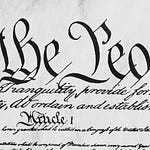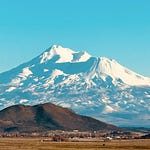This episode of Jazz Roots & Branches auditions music of the 1940s to the 1960s that comprised the sound surround of “Louie Louie,” among the most popular hit songs of the early 1960s.
There are over 2,000 recorded versions of “Louie Louie.” The three-chord earworm’s durability has inspired “Louie Louie” radio marathons, an annual International “Louie Louie” Day fête, critical citation as “the greatest rock and roll song ever,” a paranoid and ultimately fruitless FBI obscenity investigation, at least one book, too many articles to count, and an endless doom-scroll of online popular music mythmaking. What might the actual recording evidence tell us?
Latin American folk traditions have long fascinated U.S. performers and audiences. Following World War I, artists from the around the Caribbean and Latin America began converging and recording in New York, New Orleans, and Los Angeles, and folklorists began making field recordings of traditional Americana and Latin American music by the mid–1930s. Brazil’s Carmen Miranda made her New York debut in Lee Schubert’s musical revue The Streets of Paris (1939), and she co-starred as a singer (playing herself) in Down Argentine Way (1940), a film selected by the Library of Congress to be entered in the National Film Registry.
Jazz artists began incorporating Latin and Caribbean elements into their music in the latter 1930s, as manifest in recordings by Sidney Bechet, Willie “The Lion” Smith, Baby Dodds, Duke Ellington, Cab Calloway, Skeets Tolbert, Ella Fitzgerald, Louis Jordan, Nat King Cole, and Slim Gaillard, among many others. What Jelly Roll Morton identified as the “Latin tinge” runs especially through the music of New Orleans, a Caribbean cultural crossroads since the 18th century.
The New Orleans sound comes through clearly in “Salée Dame,” a 1947 number by Nick & His Creole Serenaders, echoing Dixieland jazz, Louisiana Creole folk musicians, and the 1938–1940 recordings of Sidney Bechet and Willie “The Lion” Smith. More subversively, Slim Gaillard had a trickster’s sly, uncanny vibe with Afro-Cuban, calypso, and Yiddish traditions that inspired his satirical work of the early 1950s, as on songs like “Cuban Rhumbarini” and “Make It Do.”
Media, broadcasting, the film industry, record companies, and recording artists all took note of the popularity of the “Latin tinge” and calypso following World War II. The Andrews Sisters logged a major pop hit in 1945 with “Rum and Coca-Cola,” composed by Trinidadians Lionel Belasco and Rupert Grant “Lord Invader.” Ella Fitzgerald paired with Louis Jordan on “Stone Cold Dead in the Market” by Trinidadian Wilmoth Hendricks “Houdini” (1946).
The folk and popular traditions that evolved in Texas and Southern California drew heavily on music south of the border, as with such revered Mexican American recording artists as Ritchie Valens and Lalo Guerrero. Valens’ promising career was cut short by his death in a plane crash, but Guerrero, a prolific performer and composer, fared better. The Smithsonian Institution declared him a national folk treasure (1980), the National Endowment for the Arts granted him a National Heritage Fellowship (1991), and President Clinton conferred the National Medal of Arts upon him in 1996.
The hemispheric musical crossroads of Southern California plainly informed Richard Berry’s “Louie Louie.” Berry (no relation to Chuck Berry) wrote and recorded “Louie Louie” with The Pharaohs in 1957. His inspiration was “El Loco Cha Cha,” the Rosendo Ruiz, Jr. composition popularized by Cuban bandleader René Touzet. But Berry heard the song as performed by The Rillera Brothers Rhythm Rockers, with whom he occasionally appeared on the Santa Ana-East LA club circuit.
Rather than record a cover of “El Loco Cha Cha,” Berry borrowed the Cuban riff and wrote a new song with faux Jamaican patois lyrics. This was a gimmick already proven by commercially successful artists including The Andrews Sisters, Ella Fitzgerald, Nat King Cole, Slim Gaillard, and Chuck Berry (whose “Havana Moon” song narrative Richard Berry also cited as an inspiration for “Louie Louie”). Most notably, Harry Belafonte’s Calypso (1956) was the first-ever LP million seller, making the novelty of calypso and Latin borrowings anything but stone-cold dead in the pop market.
Early 1960s West Coast airplay of Richard Berry’s “Louie Louie” inspired covers by Seattle’s Rockin’ Robin Roberts and The Fabulous Wailers (1961), and most famously, by The Kingsmen, whose 1963 Portland, Oregon recording shot up the Billboard charts — bested only by The Singing Nuns, Bobby Vinton, and The Beatles’ breakout “I Want to Hold Your Hand.”
The Kingsmen’s popular success provoked numerous covers of what would become a dancehall and party standard. Far too numerous to air here, but among the many are Paul Revere & the Raiders, The Beach Boys, Otis Redding, The Kinks, Mongo Santamaría, Frank Zappa, Julie London, Iggy Pop, John Belushi (in the cult classic Animal House), and — the ultimate return of the suppressed — Toots & The Maytals, whose 1973 interpretation took “Louie Louie” back to its Latin and Caribbean roots. Have a listen.
Playlist
Title | Artist | Album | Composer | Label | Date
Na Baixa do Sapateiro | Carmen Miranda | single | Ary Barroso | Odeon | 1938
Tropical Moon | Willie “The Lion” Smith-Sidney Bechet Orchestra | single | Sidney Bechet | Varsity | 1939
Rhapsody in Rhumba | Cab Calloway & His Orchestra | single | Cab Calloway | OKeh | 1940
Bakiff | Duke Ellington | The Blanton Webster Band | Duke Ellington; Juan Tizol | RCA Victor | 1941
The Rhumba Blues | Skeets Tolbert | single | Skeets Tolbert | Decca Sepia Series | 1941
Cuban Rhumbarini | Slim Gaillard | single | Slim Gaillard | Cadet | 1945
Los Chucos Suaves | Lalo Guerrero | single | Lalo Guerrero | Imperial | 1949
Rum and Coca-Cola | The Andrews Sisters | A Collection of Tropical Songs | Lionel Belasco; Rupert Grant “Lord Invader” | Decca | 1945
Stone Cold Dead in the Market (He Had It Coming) | Ella Fitzgerald with Louis Jordan & His Tympany Five | single | Wilmoth Hendricks “Houdini” | Decca | 1946
Salée Dame | Nick & His Creole Serenaders | single | Albert Nicholas; Danny Barker | Circle | 1947
Make It Do | Slim Gaillard & His Internationally Famous Orchestra | Wherever He May Be | Raymond Bloch; William Friedman; Mal West | Nogran | 1952
Calypso Blues | Nat King Cole | single | Nat King Cole; Don George | Capitol | 1950
Brown Skin Girl | Harry Belafonte | Calypso | Public Domain | RCA Victor | 1956
El Loco Cha Cha | René Touzet | single | Rosendo Ruíz, Jr. | GNP Crescendo | 1957
Havana Moon | Chuck Berry | single | Chuck Berry | Chess | 1956
Louie Louie | Richard Berry & The Pharaohs | single | Richard Berry | Flip | 1957
Louie Louie | The Kingsmen | single | Richard Berry | Wand | 1963
Louie Louie | Toots & The Maytals | single | Richard Berry | Trojan | 1973




